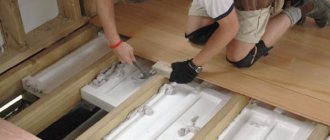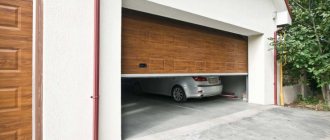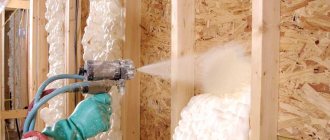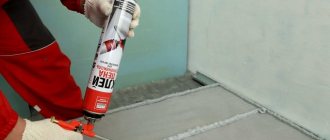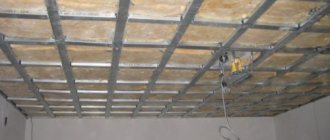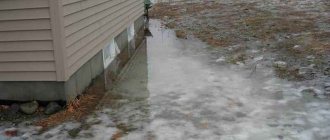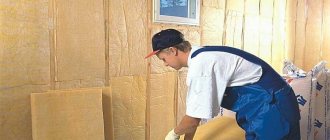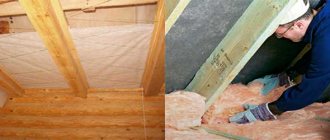Spray equipment
Polyurethane foam spraying machines accurately dose and mix the components that make up the finished mixture. From the consumable containers they enter the spray chamber through a hose. That's where the connection happens. Compressed air acts as a mixing agent. Then the resulting mixture is sprayed onto the prepared surface. The increased pressure with which the foam is supplied allows spraying to any places, including hard-to-reach ones.
Polyurethane foam spraying plants
Russian offers: PGM-3S, PGM-8S, PGM-5BN, PGM-5AT, PGM-9BN and PGM-9AT. The listed installations are reliable and lightweight. They are easy to install and move. Productivity - from 3.5 kg/min and up to 3080 cubic meters. cm/min. These are portable complexes for insulating premises. Energy consumption for machines of these brands is 0.7 kW, and with heating - 2.7 kW. The main distinguishing feature of the installations is their mobility and the ability to work at the customer’s site.
Pouring mechanisms
Equipment of the following brands is used with liquid polyurethane foam: PGM-30AT, PGM-45AT, PGM-75AT. The cars are equipped with large tanks. This makes it possible to produce thermal insulation blanks on an industrial scale (produce up to 36 kg/min). The method of pouring molded products is perfectly implemented using installations of this type. Power consumption ranges from 3.75 to 5 kW.
Universal machines
These include: PGM-10BN, PGM-10AT, PGM-18S, PGM-36S, PGM-36M. These are simple and productive machines. Characteristics: up to 30 kg/min of material and up to 34,560 sq. cm/min. This equipment can be used for on-site work and for the production of workpieces. PGM-10BN, PGM-10AT are highly versatile, so their purchase can solve several problems for thermal insulation in construction.
Why is polyurethane good for insulation?
Strengthens load-bearing structures. Very light, does not overload the walls. Moisture-resistant, therefore, no vapor barrier layer is needed. It is permissible to work with polyurethane foam at subzero temperatures (down to -10 °C). You can insulate almost any wall or facade; polyurethane foam is easily compatible with different types of surfaces. Prevents the development of corrosive and other destructive chemical processes. Has soundproofing properties. Non-flammable, which is especially important during the construction of buildings. Makes rooms much warmer. Residents can save on heating costs.
Reviews about thermal insulation with polyurethane foam
Reviews about thermal insulation with polyurethane foam
“There was a need to insulate the loggia. We chose polyurethane foam. The insulation is at the highest level, moisture does not settle anywhere. The apartment owners say they are satisfied with the work done. The adhesive properties of the foam played a significant role.”
Ivan Petrov, Novosibirsk.
“When building the house, we chose spray foam as insulation. The result was a continuous coating without joints. This made it possible to finish the walls with good lining, without fear that the surface would look uneven.”
Sergey Krasnov, Krasnodar.
“In the summer we decided to insulate the façade by spraying polyurethane foam. We hoped that this would help save on space heating costs. Indeed, they turned on the batteries only when it was already -5 ºС outside. Now the heating system is only operating at a third of its capacity.”
Vladimir Cheryomushkin, Moscow.
1Features of attic insulation
Installing insulation for the attic from the inside, as well as insulating a well from concrete rings, is a much more complex and time-consuming task than insulating an ordinary room. The difficulty lies in the following factors:
- lack of horizontal overlap on top - that is, insulation will have to be done directly along the inner surface of the roof, which usually has a triangular shape; low temperature in the attic in winter; moisture may get inside, onto the surface of the insulation (this happens when the roof is damaged) - which not every insulator can withstand.
For these reasons, the use of most other materials, if possible, will be a very, very difficult task.
By the way, regarding the relevance of the process itself: thermal insulation of the attic from the inside is needed not only in cases where it is planned to equip a living space. Even if you are not going to use the attic in any way, it still needs to be insulated.
The reason is simple: the lack of insulation leads to the fact that the temperature above the ceiling (that is, in the attic) in winter will tend to the street temperature. In addition, it is quite possible that it will also be damp inside - since the roof covering often has leaks (and if not, they can appear over time).
Spraying polyurethane foam between the joists from the inside
As a result, moisture from natural precipitation will seep into the attic, spoiling its microclimate.
Dampness, in turn, can lead to the appearance of fungus and mold, and they can appear not only in the attic itself, but also from the inside, in the living quarters of the second floor. This problem is especially relevant for owners of wooden houses with polystyrene foam - after all, wood is most “afraid” of contact with water.
Manufacturers and prices
Experts call the following companies the best producers of polyurethane foam:
BASF Polyurethanes GmbH. The German company is a leader in the production of polyurethanes. The product line also includes polyurethane foam. In Russia, together with OJSC Nizhnekamskneftekhim, they created the Elastokam enterprise to produce components for polyurethane foam.
Yantai Wanhua Polyurethanes Co., Ltd. Chinese manufacturer with a high-quality line of polyurethane foams.
SYNTHESIA INTERNACIONAL SLU The Spanish chemical company SYNTHESIA INTERNACIONAL SLU has been producing polyurethane foam since 2008. The products have found their buyers in many countries around the world, including Russia.
The price from all manufacturers is about $650 per 1 m3.
Characteristics
There is also no clarity about the characteristics of the material.
Thermal conductivity
When advertising their products, sellers indicate very low thermal conductivity values of polyurethane foam. Rarely, you can find a coefficient of 0.017 W/(m×°K), more often - 0.020-0.022 W/(m×°K). But this is from the realm of fantasy. Even in laboratory conditions, where all requirements for the quality of components and their formulation can be met, it is rarely possible to obtain a thermal conductivity index of 0.022 W/(m×°K).
Similar values are achieved only with the use of freon r141b as a foaming agent, which is prohibited for use in Europe (and therefore is not produced). The use of other foaming agents increases the value of the coefficient, and therefore in European countries a thermal insulation layer with a thermal conductivity of 0.028 W/(m×°K) is considered high quality.
In Russia, the real figures are 0.030-0.035 W/(m×°K) (the specific value depends on the experience of the performers).
However, consumers should not be upset. Even if the technology is violated, the actual thermal conductivity of the insulation deserves respect, since it is one of the best and comparable to basalt wool.
Density
The density of the insulation determines the bending strength (fragility), the weight load on the structure and the thermal insulation properties.
Two-component, closed-cell polyurethane foam, can be obtained in different densities, combined into 3 groups.
- 1 group. Low density - 28-32 kg/m3. The main scope of application is ceilings and walls from inside the room, onto which the material is applied in a thin layer. Thermal conductivity coefficient is from 0.028 to 0.032 W/(m×°K). Vapor permeability at the wood level is 0.05 mg/(m*h*Pa), which makes it possible, albeit conditionally, after detailed calculations, to use polyurethane foam for insulating the walls of wooden houses (more on the problem below).
- 2nd group. Average density - 32-40 kg/m3. A classic representative of the species. The components are sold separately, in cylinders. Used to insulate all structural elements of a building. It has the lowest percentage of moisture absorption among all types of insulation.
- 3rd group. High density - 40-80 kg/m3. Achieving such density using portable equipment is theoretically possible, but practically impossible. It is used in places with high mechanical load on the heat-insulating layer, but only after special surface treatment, which experts call armoring.
Life time
Manufacturers of polyurethane foam consider their products to be durable, with a service life of 30-50 years. These figures are confirmed by the experience of using this insulation in the USA and Europe. However, in Russia, in the first years of using the new product, they were faced with the fact that the insulation from the facades of multi-storey buildings began to fall off in layers after 5-6 years of operation.
At first, the root of the evil was seen in the poor adhesion of polyurethane foam to the wall material. When the lag became widespread, they began to study the problem seriously and turned to Western experience. It turned out that the reason is in a completely different plane - the sun's rays. The material does not tolerate ultraviolet irradiation, ages, or in the language of scientists: it is subject to UV destruction. The aging rate is about 1 mm per year.
The worst enemy of polyurethane foam is the sun.
Simply painting the insulating layer with fade-resistant paint or mastic protects the material from destruction, extending its service life to 30 years when the facade is open. If the insulated facade is finished with siding or porcelain stoneware, you don’t have to worry about the safety of the insulation at all.
Adhesion
Foamed polyurethane has excellent adhesion to all types of building materials, with the exception of polyethylene film. For example, in order to tear polymerized insulation from concrete, you will have to apply a force of at least 2.5 kg/cm2, and for steel - 1.5 kg/m2. These are very large numbers. No wonder the best types of glue are polyurethane based. But such adhesion is possible only if the insulation is sprayed onto a clean and dry surface.
The insulation will not adhere to whitewash and “boiling” plaster; it will fall off along with them under minor mechanical loads due to low bending strength.
Is penoizol harmful to health?
*
After testing, Russian manufacturers were convinced of the safety of using penoizol. There are certificates confirming this. But polystyrene foam is prohibited in Canada and is not used in the USA as insulation. In the UK, safety guidelines are followed regarding the use of urea foam as a toxic substance. The problem lies in the concentration of formaldehyde, which is released during polymerization. At high concentrations in the air it causes allergies and tumors in the future. Therefore, it is very important to use high-quality materials and adherence to pouring technology. In high-quality products and in the hands of craftsmen, the minimum content of formaldehyde is safe.
Cost of installation work
The price of ceiling insulation with polyurethane foam should include not only the cost of the material itself, but also the cost of installation work. This is due to the fact that you won’t be able to do the spraying yourself. Requires special equipment and certain skills. Therefore, installation work will have to be ordered from specialists.
Today the following prices apply for the installation of sprayed heat insulation:
- price per square meter starts from $9.6;
- in the case of spraying a significant layer of polyurethane foam, the calculation is made in cubic meters (in this case, prices start from $120 per cubic meter).
Effective and durable ceiling insulation with spray polyurethane foam will keep your home warm and quiet. With this insulation, the owners of a residential building or apartment can forget about problems with thermal insulation of the room for half a century.
Where can it be used?
You can insulate with polyurethane foam both residential or industrial buildings (inside or outside), as well as window or door openings, as well as fill voids formed in the walls when laying communications and pipes. The miracle sealant easily fills even small gaps, preventing the formation of insidious drafts. Walls, floors and ceilings can be easily insulated. It protects the tree from rotting and fungal mold. Iron – from corrosion.
The environmental friendliness of the sealant allows it to be used even in such matters as insulating a nursery. Therefore, if we return to the topic of our article: “Is it possible to insulate a house using polyurethane foam? “- the answer will be definite. It is possible and even necessary! Of course, the high price of polyurethane foam sealant may scare you away, but the advantages mentioned above will definitely be worth the money you spend on insulating your home. However, one should not forget about one nuance - the use of this type of insulating material makes the insulated room almost airtight, which means that the building or room must have well-thought-out ventilation so that problems of stuffiness or stale air do not arise.
Polyurethane foam is suitable for insulating hangars, garage doors, garages, facades, windows, as well as balconies and bathtubs. Using the material, you can insulate the area between the walls between the brick and the block. Waterproofing with it from the inside and on the roof is more reliable.
To learn how to insulate a balcony with polyurethane foam, see the following video.
Optimal solution
And now we move on to the most interesting - the most effective solution in all respects. We are talking about foamed polyurethane - a unique composition, which, after being applied to the surface even in the thinnest layer, reacts with air and foams, increasing 100 times! At the same time, it forms an almost weightless substance, more than 90% consisting of air.
What features does this insulation material have:
- PU foam can be applied to any surface – it doesn’t matter whether your ceiling is concrete or wooden. Foamed polyurethane is easy to apply and adheres well to any substrate.
- This material does not burn - the fire safety class is confirmed by the corresponding certificate for polyurethane foam.
- Made from environmentally friendly materials, therefore absolutely harmless
- It is applied by spraying - this allows you to significantly reduce the time it takes to insulate the ceiling, since the process is similar to ordinary painting
- Allows you to achieve complete tightness - the material fills all the cracks, all the recesses, all the joints, and then expands, completely sealing them. This provides the highest degree of thermal protection
- Resistant to moderate mechanical stress
- Does not require significant reduction in ceiling height
And now there is one more advantage - the second “hare” that we talked about at the beginning
Foamed polyurethane "Ecotermix" additionally provides a high level of sound insulation, which is especially important for residents of apartment buildings! Therefore, by choosing this method of insulation, you win doubly. And the durability of this material (service life up to 50 years) makes its use even more expedient and profitable
Features of foam insulation
The installed foam insulation is a porous polymer mass. The working solution is applied under pressure to the wall or ceiling, foams upon contact with air and hardens. Numerous gas bubbles provide thermal insulation and protect the premises from street noise and vibrations. The elastic structure of the material has sufficient strength and is able to withstand significant static and dynamic loads, increasing the overall strength of the roof.
Sprayed coatings do not have seams and joints through which heat leaks occur in other types of thermal insulation materials.
Do-it-yourself DUGA® P1 equipment
The need to insulate your own home, cottage, garage with high-quality durable material with a high thermal insulation coefficient, the absence of cold bridges, a simple and reliable method of fastening/application, as a result of considering all the options, often leads to the decision of self-spraying polyurethane foam. After choosing polyurethane foam as thermal insulation, there is a need to purchase ready-made equipment for spraying it, or a desire to make equipment for polyurethane foam with your own hands. Considering the unreasonably high cost of so-called “one-time installations” for spraying polyurethane foam with the impossibility of subsequent use, a reasonable choice would be to purchase an inexpensive ready-made installation, with which you can spray polyurethane foam not only on a specific object today, but also to use it in the future, or even try assemble the equipment for the power supply unit with your own hands. Technically, at first glance, an installation for spraying polyurethane foam is really not anything complicated: a drive, pumps, a sprayer. However, often numerous attempts to make equipment for PPU with your own hands lead to unplanned results: the components “press” each other, a stable required ratio is not ensured, pumps that are not intended for pumping PPU components leak and jam, the sprayer requires a lot of air and does not provide high-quality mixing and sprayed foam onto the surface. In addition to wasted money and lost time, an installation assembled from unsuitable components not only does not fulfill its direct task, but also discredits the very idea of thermal insulation with polyurethane foam due to total savings and the lack of the required technical knowledge and experience necessary when designing any equipment.
For those who want to assemble equipment for the PPU with their own hands and, thereby, reduce the cost of insulating their home, the Vladimir Construction Equipment Plant offers a choice of two solutions:
1. kit for self-assembly of equipment for the DUGA P1 power supply unit:
The cost of such a kit, due to reduced production costs, is lower than the price of a finished installation and amounts to 56,920 rubles including VAT. The kit includes all products and parts that are used to assemble the DUGA P1 equipment, in addition, the kit includes hoses for sampling and supplying components, remote control, spare parts, instructions for assembling and using the installation, a passport, technological instructions for polyurethane foam.
By purchasing a factory kit for assembling equipment for the do-it-yourself control unit ARC P1, you receive:
It is also necessary to understand that the quality of assembly and configuration of the equipment, ensuring the production of polyurethane foam with the necessary characteristics in this case, lies entirely with the buyer. The factory warranty valid for finished DUGA equipment does not apply to the purchased kit for the reason stated above.
2. Do-it-yourself household installation for applying polyurethane foam ARC P0
This option seems optimal for most people who want to independently insulate their home, garage, bathhouse, extension, etc. with polyurethane foam. By purchasing such an installation, you receive a complete set of high-quality factory equipment for applying polyurethane foam yourself, including: supply hoses, a pumping unit, supply hoses for components and compressed air, a professional spray gun, detailed instructions for working with equipment and polyurethane foam. The unit has a full factory warranty - 1 year, is equipped with high-quality gear pumps of our own production, designed to work in an environment of PPU components. You can watch a video of our clients insulating their homes using the DUGA P0 installation on our YouTube channel. You can learn more about the installation on our website: household installation ppu DUGA P0.
"VZSTO" Design and production of innovative equipment for construction, road and repair work, as well as work related to construction chemicals, including waterproofing and thermal insulation
Designing a water supply system in an apartment
Preparing the correct water supply layout project will allow you to avoid problems both at the stage of pipe installation and later, when using water-consuming equipment.
You should accurately determine the list of plumbing fixtures and stationary household equipment that consumes water, the installation of which will be carried out in the apartment. Then draw a plan of the apartment to scale, mark on it the positions of devices that require connection to the water supply.
It remains to determine the pipeline decoupling scheme, which takes into account all water-consuming stationary equipment in the plan. In addition to water consumers, the diagram indicates equipment that is part of the water supply system (water meters, pumps, etc.), the length of pipeline sections and pipe diameters.
It is more practical to run water supply lines along the walls - in grooves or on top. If necessary, you can sheathe the surface line with a box made of plastic or plasterboard (+)
Ideally, the diagram should take into account the positions and characteristics (size, type) of adapters, fittings, couplings, etc. However, this is only feasible for a plumber. It’s easier to prepare a project without these “details”, go with it to a plumbing store and show the project to the seller. He will help you select the necessary “small” components.
But before you go for pipes and fittings, you need to make a hydraulic calculation of the water supply system project. This will make sure that there is no significant drop in pressure in the designed water distribution system and its ability to provide water to all consumers when they operate simultaneously.
The most common spraying of polyurethane foam is used:
- When insulating floors on the first floors of residential buildings and in basements.
- During the insulation of building roofs; in such cases, depending on the type of roof and whether people will walk on it, different brands of polyurethane foam are used, differing in density.
- Insulation work for vegetable stores; in order to save money, it is possible to use low-density polyurethane foam.
- Low-density polyurethane foam (from 20 to 30 kg/m3) can also be used for attic insulation work, but in this case it requires the creation of a thicker layer (from 12 to 15 centimeters).
- Standard grades of polyurethane foam, when applying a layer of 5-7 centimeters, are used to insulate the walls of residential buildings. If we are talking about houses made of wood, it is advisable to use vapor-permeable grades of material, which will ensure air flow to the wood.
- To fill ventilation gaps in residential buildings, you can use polyurethane foam with a minimum density (15 kg/m3).
- Using this material, the foundations of any premises are insulated.
- The material is also suitable for insulating pipelines, but in such cases the brand and thickness of the layer are determined based on how hot the pipes themselves are and what temperature would be optimal for them in order to avoid premature failure.
Prices for spraying polyurethane foam per m2
| Name of works | Insulation thickness, mm | Cost per 1 m2, rubles including VAT |
| Sprayed polyurethane foam, core density 8-12 kg/m3, open cell. (material Elastospray 1601/15, BASF) | 50 | 450 |
| 100 | 650 | |
| 150 | 900 | |
| 200 | 1200 | |
| Sprayed polyurethane foam, core density 30-35 kg/m3, closed cell. (material Elastospray 1622/33, BASF) | 30 | 570 |
| 50 | 950 | |
| 80 | negotiable | |
| 100 | negotiable | |
| Work on pouring polyurethane foam into the cavity, open cell density 8-12 kg/m3. (material Elastopor H2401/100, BASF) | from 9500 rub/m3 | |
| Work on pouring polyurethane foam into a cavity, closed cell density 40 kg/m3. (material Elastopor 1701/20, BASF) | From 16,000 rub/m3 |
Spraying of polyurethane foam is carried out using our own installations. Before starting work, the dimensions of the insulated surfaces are assessed, after which a contract for the provision of services is drawn up and the spraying process is carried out directly.
The warranty on the material itself, depending on the brand, can range from 25 to 30 years, even without special care.
Spray insulation PENOPLEX FastFix 850 ml
Sprayed one-component insulation - a universal one-component polyurethane aerosol spray - is used for insulation of building structures, domestic and commercial premises. Insulation can be applied to any surface, including vertical surfaces and surfaces with a negative slope (inner surfaces of roof slopes, etc.). Ideal for small spaces. It can also be used as an auxiliary insulation for application on uneven and geometrically irregular surfaces, as well as where it is technically difficult to use sheet insulation. Heat resistance (of fully cured adhesive foam) during long-term use: from -45°С to +90°С Area of one cover layer during continuous application (depending on the nature of application), m²: Up to 2.2
PROPERTIES:
- for external and internal work;
- due to its finer-cell structure, it has lower thermal conductivity than polyurethane foam and better insulating properties
- output volume after lifting the cap – up to 55 liters;
- the rise of one layer is up to 2.5 cm. It is recommended to apply in several layers. Apply the second layer only after the first has cured.
- temperature range of use – from -0 to +30 °C (at a cylinder temperature from +10 to +35 °C);
- operating temperature range – from -45 to +90 °C;
- complete curing time – 12 hours;
- after polymerization – chemically neutral, does not emit toxic compounds;
- resistant to mold and fungi;
- excellent adhesion to all surfaces, with the exception of fluorine plastic;
- does not contain ozone depleting substances or solvents.
SCOPE OF APPLICATION:
- insulation of walls, ceilings, roofs, basements, doors, building structures, etc. in premises for economic and domestic purposes;
- as an auxiliary insulation when using insulation from polystyrene foam, basalt, etc.
- ideal for insulating geometrically irregular surfaces;
- sealing gaps between thermal insulation elements;
- spraying on sheet materials to reduce vibrations and for sound insulation.
- can be used for comprehensive insulation of cracks, holes, joints together with mounting foam and mounting adhesive foam
Color: Bright orange.
TECHNICAL CHARACTERISTICS: Density of the finished product after spraying and polymerization, kg/m³ no more than: 16-20
Volume of the finished product after spraying and polymerization, liters: 50-55.
Lifting height of the cap of one layer, mm: Up to 25.
Surface drying time (to touch), min., no more: 15-20.
Curing time, min: About 60.
Complete curing time, hours, no more than: 24.
Time for possible further processing, min., no more: 90.
Thermal conductivity, W/mK: 0.025.
Recommended number of layers when spraying: 1-2.
Fire resistance class (DIN 4102-1): B2.
Thermal insulation of a house using polyurethane foam
The technology of insulating a house with polyurethane foam is valued for its efficiency and speed, meeting safety standards, and excellent insulating properties.
It is suitable for any external and internal structures, including loaded ones, the only limitation of application is the high price. Reviews from building owners are mostly positive; many are thinking about purchasing equipment.
Among the noted advantages are high adhesion, the absence of cold bridges, the ability to process complex and hard-to-reach areas, strength and resistance to moisture and fungus.
Features of polyurethane foam
The technology is relevant for any building surfaces, including metal. Moreover, it successfully protects the latter from corrosion by forming a film directly on the area in contact with the pipe or fittings.
Cured foam is completely impenetrable to external influences and is only afraid of mechanical damage and UV rays. There are two varieties: with an open and closed cell structure; in the cold climate of the Russian Federation, the second, more expensive and dense, is more often used for construction purposes.
This type of polyurethane foam belongs to the class of materials that are difficult to ignite and prevents the spread of flame.
Density is a controlled indicator, on which the cost of spraying polyurethane foam directly depends.
Changing the chemical composition and equipment settings allows you to vary this characteristic from 15 to 80 kg/m3 (it can be higher - up to 300, but according to reviews this is not necessary), which is important when insulating structures with varying degrees of load.
There is a clear relationship between the volume of foam formed and the ambient temperature (with the same insulation thickness, 17% more components are consumed); in the cold season, additional heating is required.
PPU with a closed structure has vapor permeability close to zero, this limits its use in internal insulation schemes. In any case, it is not recommended to completely cover both the floor and walls with it in unventilated rooms. As an option, a composition with a density below 12 kg/m3 with open cells and appropriate vapor and waterproofing is used.
Technology and basic circuits
Work on insulating polyurethane foam begins with choosing its density, taking into account the load-bearing capabilities of the structures and the thickness of the future layer according to the climatic conditions of the region. When doing it yourself, it is recommended to adhere to the following scheme of actions (using the example of a facade):
- Surface preparation: applied to stable, clean and dry structures, heated if necessary. Evenness does not play a special role, but there should be no peeling pieces of the old coating.
- Installation of sheathing (recommended). Theoretically, a frame is not needed, but installing guides helps control the level and facilitates the finishing process. The height of the sheathing is selected taking into account the future thickness of the insulation.
- Application of polyurethane foam: in a thin layer (no more than 5 mm) in the direction from bottom to top. If necessary, the process is repeated.
- Upon completion of the polymerization process, excess foam is cut off along the guides and external finishing is carried out. To plaster polyurethane foam, a chain-link mesh must be placed (similar to polystyrene foam, secured to the sheathing or material). The easiest way is to cover the facade with siding, clapboard, or, if you have an unlimited budget, to cover it with brick.
This guide is also suitable for roofs or floors on joists; experienced operators use up raw materials without leaving a trace, even without lathing.
It is allowed to use polyurethane foam in systems with heating elements (both pipes and cables); it is believed that such insulation reduces space heating costs.
When insulating pipelines, containers or metal walls, the preparatory stage includes the removal of old flaking paint and rust. A mandatory step in any scheme is sealing and hiding from ultraviolet radiation.
Thermal insulation of the façade with foam insulation and cladding with cladding slabs
This method of insulation is used only for exterior decoration of the house. The scheme of work is as follows:
- The number of slabs, galvanized steel profiles or other elements for the entire facade is calculated. A galvanized steel frame is attached to the facade of the building with dowels and screws. That is, it is a metal cladding attached vertically;
- Plates (metal or plastic facing panels) are installed and secured to the frame;
- Holes of 35-40 mm are made in the casing at a distance of about 2 m from each other. Penoizol is poured into them using a pump;
- The holes are filled in a checkerboard pattern from bottom to top.
- After completion of the work, the drilled holes are sealed;
- The façade is being decorated.
Using slabs for facade insulation
Each of the above methods of insulating a house with foam insulation has its own advantages, but they are all united by an unusual insulation with excellent thermal insulation characteristics.
Application technology
The most common method of polyurethane foam insulation is spraying onto the structural elements of the building.
PPU is sprayed onto the walls.
But there is another way - pouring, which requires a space closed on all sides. It is mainly used in factories producing sandwich panels.
Filling with polyurethane foam.
On the floor
Before spraying insulation on the base of the floor, preparatory work is carried out, including: removing the old screed, repairing the concrete base (in a wooden house the subfloor is being restored), waterproofing the ceiling or subfloor. The preparatory process is described in more detail in the material “Preparing the floor for pouring screed.”
A lathing for laminate, parquet, linoleum or joists for floorboards is mounted on the prepared surface. At the same time, both the sheathing slats and the joists should be 20-30 mm higher than the insulation. The gap is necessary to ensure ventilation.
On the walls
The technology for insulating the facade and walls from inside the room is the same. Consists of sequential operations:
the old finish is removed from the surface of the walls (you can see how to quickly remove it in the work “Aligning walls for painting”); the sheathing is installed; polyurethane foam is sprayed
In this case, special attention must be paid to corners, crevices and voids; areas with protruding insulation are trimmed with a knife (easy to detect as a rule); Drywall is attached to the sheathing for finishing with wallpaper, painting or decorative plaster.
To the ceiling
Insulation of the PPU ceiling is carried out under a suspended or suspended ceiling. In this case, the old finish is removed from the surface of the floor slab, after which foam is applied in a thin layer (lathing is not required).
On the roof
The roof is one of the few places in the house where you can do polyurethane foam insulation work yourself. To do this, you need to buy special kits with 2 small cylinders and a sprayer. The containers contain the starting reagents, and a sprayer is needed to mix the components. But before starting work, you need to calculate the financial costs so that the roof does not literally turn out to be golden.
Semi-professional kit for PPU insulation.
Preparing the roof for insulation is simple: the surface is dust-free and dried. PPU is applied from the inside between the rafters. After the foam has hardened, the thermal insulation layer is covered with sheets of plywood or OSB.
PPU roof insulation scheme.
The editors of the portal StroyGuru.Com tried to objectively talk about such a controversial insulation material as polyurethane foam. Having complete information about the material, you can make an informed choice and avoid mistakes.
Consumer properties
Like any insulating material, Polynor has a number of advantages:
- Features excellent heat conservation. These insulation indicators are higher compared to expanded polystyrene and mineral wool.
- Non-toxic. Consumer reviews about Polinor are quite good, since it is not poisonous and does not require protective equipment when using it.
- Ease of use. When using POLYNOR, a heat-insulating layer is created, which does not require a frame for fastening. Also, no tools or auxiliary materials are required.
- Excellent grip. The composition quickly adheres to any surface - brick, wood, plastic, stone, concrete, which significantly expands the scope of its application.
Polynor insulation is very popular due to the fact that it is applied by spraying. This affects better adhesion of different surfaces, even if they are not very smooth. Very often this insulation is used to finish hard-to-reach places, for example, where pipes or cables are laid.
Video: Insulating the floor in a frame house on screw piles with polyurethane foam
In general, there are two types of polyurethane foam Perlon U and Igamid U. The first is elastic polyurethane foam, the second is rigid, the same one that is used for insulation.
Do you want a surprise? What do you think is the name by which we all know the first of the above-mentioned types of polyurethane foam? You can draw a parallel in consonance... Did you guess it? Yes, that’s exactly what foam rubber is known to everyone.
Now the question is: where is foam rubber used?
Yes everywhere! Children's toys, furniture, car seats - the list goes on and on!
Can you imagine that material containing any toxins could be approved for use in children's toys? Everywhere?
Durability. Your benefit: you insulate yourself once. For life. The exception is moving to another home.
Theoretically, polyurethane foam is designed to last for 25-30 years, but as practice shows, it lasts much longer. In our country, this material began to be used for insulation recently, but in Germany, houses insulated with polyurethane foam more than 50 years ago still serve to this day and do not cause any trouble to their owners.
Application
It is allowed to use Polinor insulation both inside and outside the house. At the same time, make sure that it is not directly affected by sunlight and moisture. The installation process is very simple and quick, and even an inexperienced person can cope with the task. All that is required is to install the container on the spray foam gun.
But before this, it is important to properly prepare the surface. It must be cleaned of dust, dirt and moistened with water. The process of applying foam is performed with smooth movements, without jerking. Thanks to this, you can obtain a uniform layer of insulation. Polymerization occurs through reaction with moisture. If you additionally moisten the surface, the composition will be more voluminous. Rubber door seals can provide additional insulation.
Video showing the use of sprayed polyurethane insulation polynor:
In addition, the material becomes lush even at a temperature of 20 degrees. But at a temperature of 15 degrees, the composition becomes dense. The material can be applied both to the frame and to the wall. The choice of a particular method depends on the subsequent cladding.
The following options are provided:
- applying paint;
- applying a layer of plaster;
- use of drywall, OSB, lining, siding.
Polynor insulation is sprayed on in several layers. It can be used not only for thermal insulation of walls, but also floors and roofs. It is often used when insulating various metal tanks and communications.
The sprayed composition is able to pass through all cracks and hard-to-reach places, forming a monolithic seamless layer. It will not allow heat, steam and moisture to pass through. The material should only be applied with gloves and safety glasses, as it has a strong and pungent odor. It is very difficult to be in an unventilated room, but after installation the smell disappears very quickly.
You may also be interested in learning about which insulation for external walls under plaster is best to use.
But this information will help you understand what a wall pie of a frame house with basalt insulation is and in what cases it is used.
What are the characteristics of mineral wool insulation and where can it be used and how exactly. This video explains it in great detail.
And this information will help compare the thermal conductivity of insulation materials.
This article will help you understand what Energoflex water supply pipe insulation is and where it is most often used.
Sputtering process
If you have entered into an agreement with a company, a minibus arrives at the appointed time. It contains spraying equipment. To operate a high-pressure apparatus, a voltage of 380 V is required. If you only have 220 V, you usually start a generator that produces the required voltage. A low-pressure apparatus can operate from a 220 V network, but, as discussed below, the quality of thermal insulation will be significantly worse.
Typically, only hoses are pulled into or around the house to supply the foam components to the gun. It's comfortable. Workers who spray thermal insulation are dressed in protective suits, wearing a respirator, gloves and goggles. A respirator is necessary, since before hardening the components of the foam are toxic, and everything else is to protect the skin from ingress of polyurethane foam, which then cannot be removed.
The foam is applied from bottom to top, in small portions. Fill everything in without skipping, trying to prevent the formation of shells. As the foam expands, make sure that the layer thickness is no less than the required one. After the foam hardens, the excess can be cut off, but the deficiency cannot be made up for.
Which variety to choose
In many ways, the choice will depend on the specific situation and what area needs to be treated. Using an example, we can consider the most common cases when a house needs foam insulation:
- If you need to seal cracks or eliminate any other defects on the surface, then polyurethane is suitable. But such material should not be exposed to sunlight.
- If you need to fill a large volume, then penoizol is suitable. But an ordinary cylinder will not be enough; you will need to purchase a special device with high pressure. You don’t have to buy it at all - you can rent it or borrow it from friends, because no one will use it often.
- If you need to seal small cracks and carry out thermal insulation in small areas, you can buy a cylinder with regular polyurethane foam. It does not support combustion, after hardening it is particularly hard, and it has an ecological composition.
- If defects are found on the outside of the wall, then you need to apply a composition based on polyurethane. It is applied directly using a special cylinder or apparatus.
It is worth remembering that foam insulation creates errors inside the layer that need to be eliminated.
To do this, you will need a long hose to push the material inside. If it is necessary to fill air gaps inside the insulation, then holes are made in the wall with something sharp. Polyurethane foam is not suitable for insulating the entire external facade - it does not have the appropriate characteristics necessary for this. Therefore, you should not choose it for these purposes, even despite its more economical cost.



